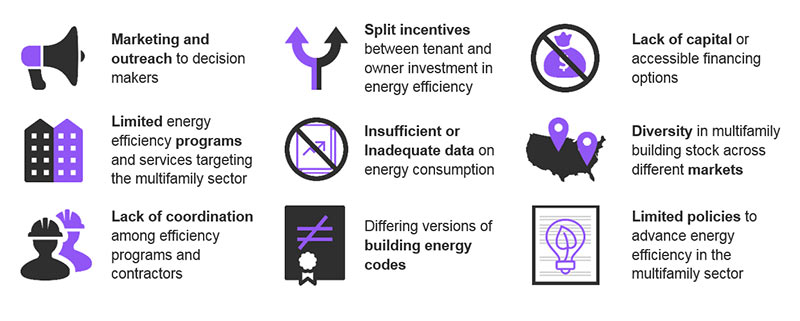By Darren Port | Thu, January 19, 17
Recently five collaborating Regional Energy Efficiency Organizations (REEOs) - NEEP, MEEA, SPEER, SWEEP and SEEA - published a white paper entitled, “Multifamily Energy Efficiency Retrofits: Barriers and Opportunities for Deep Energy Savings.” The paper, supported by a grant from the MacArthur Foundation, is a comprehensive exploration of the barriers and opportunities to increasing energy efficiency through the retrofit of multifamily buildings. There is also a companion webinar that offers an overview of the paper and case studies of multifamily projects that succeeded in implementing multifamily building energy efficiency initiatives.
Inherently green by primarily being located in densely populated urban centers, multifamily buildings are posed to fulfil the promise of city planners by taking steps that will lead such buildings to provide cost effective housing across incomes. Nationally, there are over 23 million housing units—18 percent of the total housing market—that are categorized as multifamily.[i] The potential for energy reduction in multifamily buildings is enormous; by initiating cost effective, deep-energy retrofits that reduce energy consumption by between 15 and 30 percent, the annual energy cost savings nationally could be near $3.4 billion.[ii]
Barriers
These saving, however, are not achievable without addressing a number of barriers. Major barriers include:
- Limited energy efficiency programs and services targeting the multifamily sector;
- Spilt incentives between tenant and the owner investment in energy retrofit measures;
- Lack of data on energy use;
- Constrained policies to advance efficiency in the sector;
- Scarcity of capital and financing options.
All of the above factors layered upon a wide spectrum of building typographies, fuel types, various code versions, energy pricing inconsistencies (residential verse commercial rates) and general lack of coordination among lenders, utilities, building owners, contractors, and other service providers add difficulty to multifamily building retrofits.

Split-Incentives
The majority of multifamily building occupants, nearly 88 percent, are renters.[iii] This fact plays directly into the most persistent barrier to efficiency the “spilt-incentive.” It’s the age old conundrum of the building owner carrying the financial burden while the tenant reaps the benefit. It’s a big challenge, but not impossible. The paper offers case studies of programs that address and offer achievable solutions to this issue. For example, Con Edison in Brooklyn and Queens was faced with a large infrastructure investment to meet energy demand. Instead of building more generating capacity and erecting more poles and wires, Con Edison targeted multifamily building owners, offering them no-cost energy retrofits for common spaces and tenant units. Known as Demand Management, ConEd solved the split incentive obstacle by lowering the demand for power generation while increasing efficiency for both the owner and tenant; efficiency proves less expensive than generation.
Opportunities for Utility Programs
Opportunities for utility program administrators to more adequately address the multifamily sector are delineated in detail within the paper. Administrators have to address both market rate and affordable multifamily sectors; often there are both types of units within the same building. Foremost is making a commitment to acknowledge the sector in general and more specifically through initiatives such as:
- Direct Install programs;
- Creating “One-Stop Shop” program design;
- Market assessments to identify customer usage and needs;
- Pay-for-Performance programs to incentivize retrofit actions and;
- Geo-targeted energy efficiency programs.
Opportunities for Policy Makers and other Stakeholders
Policy makers and other stakeholders also need to direct resources toward the multifamily sector. There is a multitude of options to enhance the multifamily retrofit market and real estate in the larger context. The comprehensive list below presents robust opportunities for leaders at all levels of government, program administrators and the not for profit sector. A regulatory environment utilizing readily available strategies can ensure neighborhood stabilization and security through energy efficiency. The paper dives deeply in the following initiatives:
- Building energy benchmarking and transparency policies;
- Building energy data transparency in the real estate market;
- Adoption of the latest and most efficient model energy and green codes;
- Training for building officials, plan reviewers, code inspectors, architects, builders, and trade personnel on energy efficient code compliance for multifamily buildings;
- Creating a specific multifamily building code;
- Affordable, easiliy accessiable finicianing;
- Energy efficiency requirements in qualified allocations plans for low income housing;
- National, regional, or statewide multifamily energy challenge for existing apartment portfolios;
- Streamline access to energy analysis and planning tools.
Case Studies
The paper contains eight cases studies representing various regions of the country, affordable and market rate projects, small to large programs and an assortment of building types. Each case study demonstrates success in overcoming barriers identified to achieving energy savings in the multifamily market.
Final Thoughts
The immersed analysis of the barriers and opportunities presented in the paper can be utilized as a guide for communities of all scales in tackling the hindered multifamily market. By building partnerships with diverse stakeholders creative and financially viable programs and initiatives can revive multifamily housing, from underserved to bright examples of energy efficiency.
The REEOs
The REEOs partner with a broad range of regional stakeholders and work to advance energy efficiency in the built environment through technical assistance, policy development, and program design and implementation. Your local REEO can assist organizations in creating local partnerships to find solutions to a myriad of energy efficiency concerns.
[i] U.S. Census Bureau, 2010-2014.
[ii] “Fact Sheet: The Multifamily Energy Savings Project” ACEEE. http://aceee.org/files/pdf/fact-sheet/FS-multifamilyproject.pdf
[iii] EIA, HC2.1, 2009.